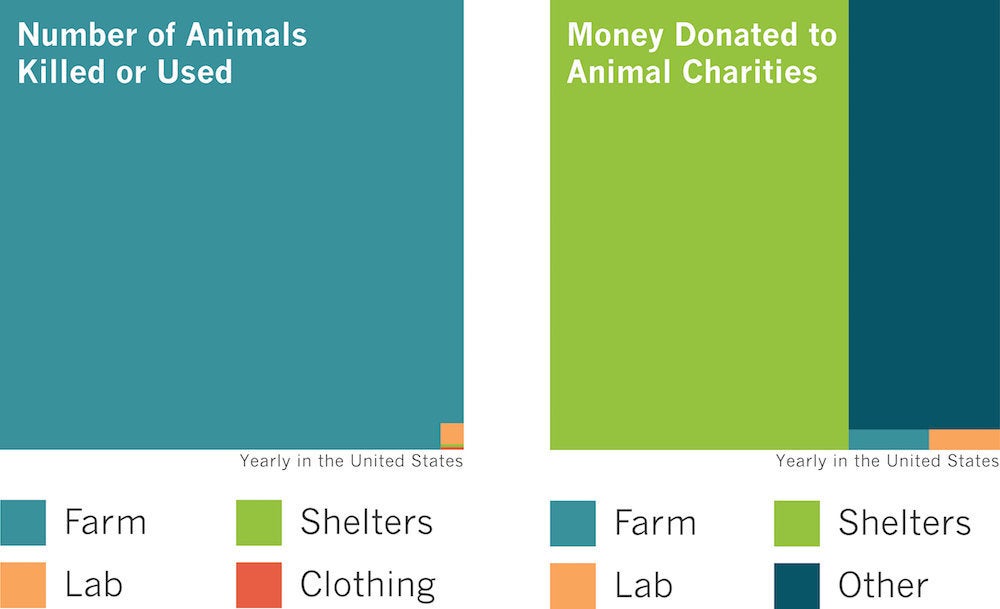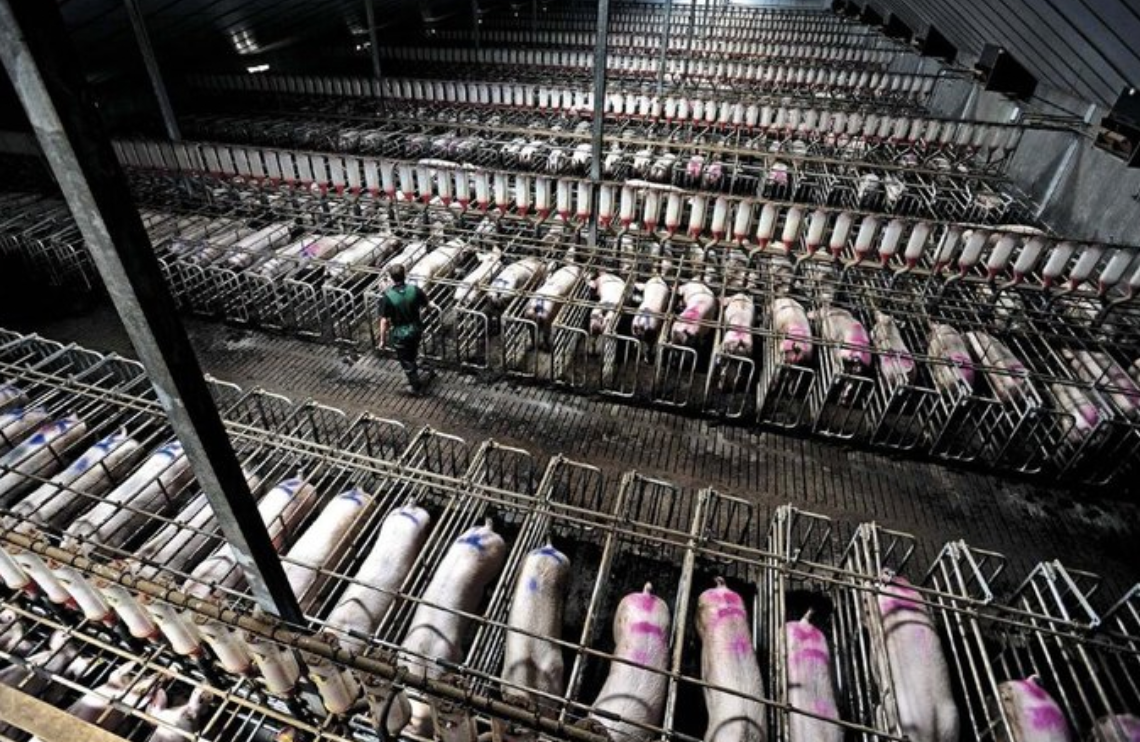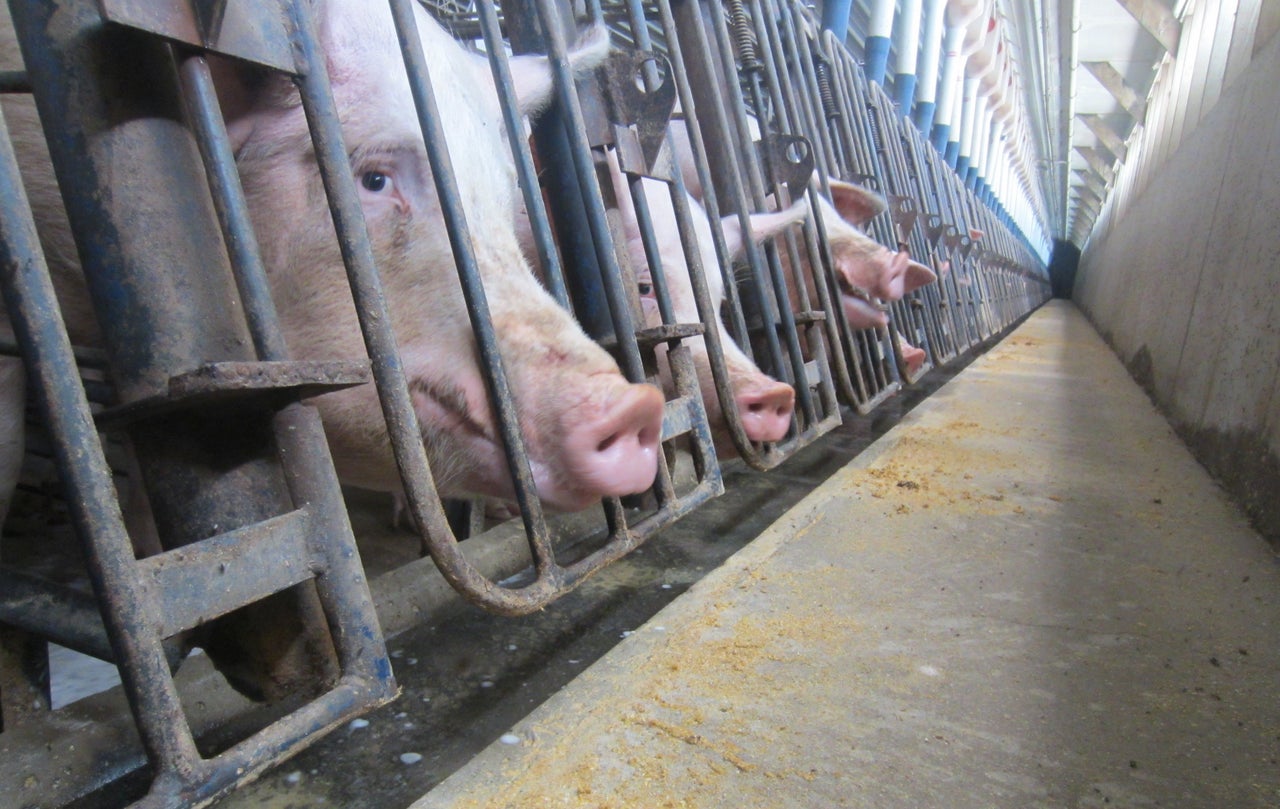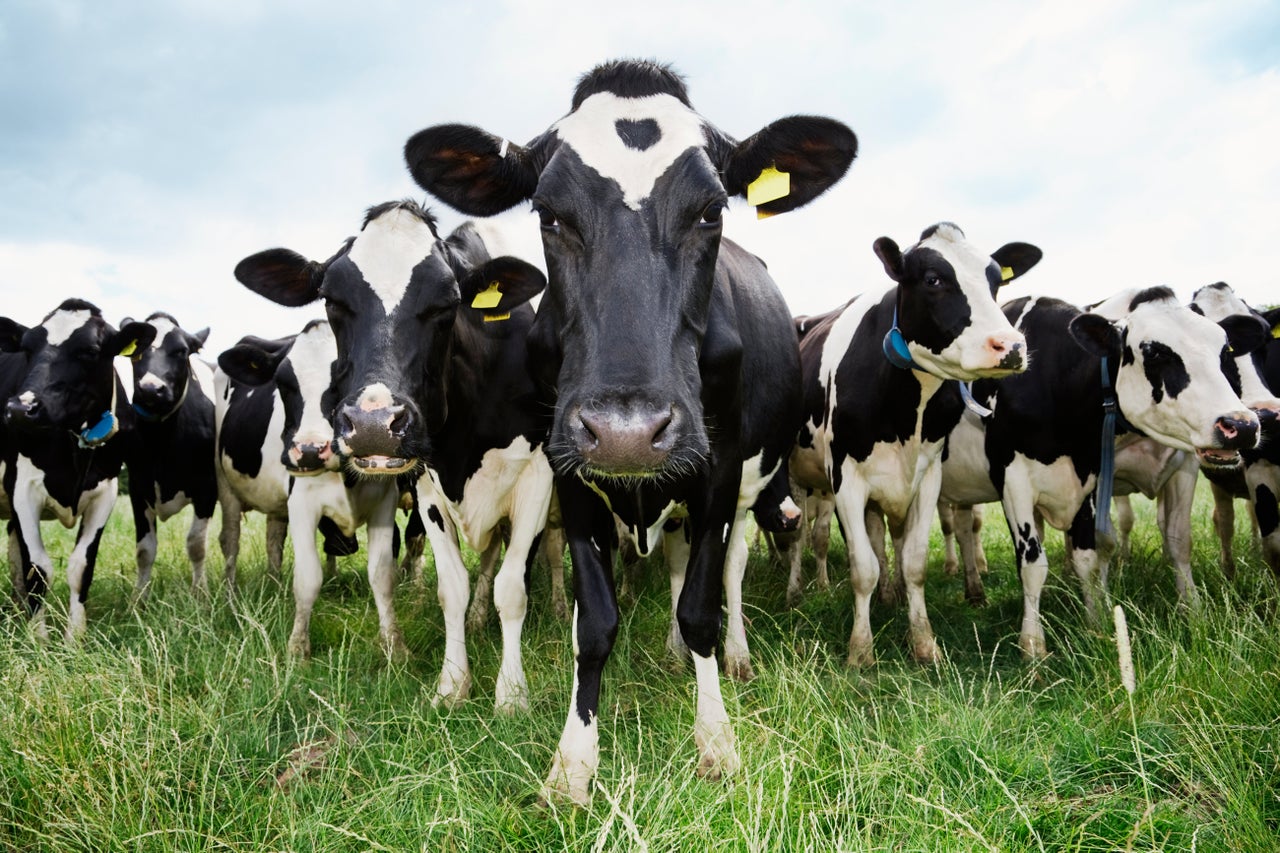When it comes to animal suffering in the United States, farm animals are in a category of their own.
True, hundreds of thousands of dogs and cats are euthanized each year in shelters. Plenty of other animals are killed to produce clothing or are used in lab tests, circuses or theme parks.
But all of them combined don't add up to even a half percent of the animals killed for food each year.
This vast disparity is not reflected in how Americans spend their charity dollars. Quite the opposite.
Americans give well over $1 billion to animal welfare groups each year. Only a tiny sliver of that money, about four-fifths of 1 percent, goes to nonprofits devoted to protecting factory-farmed animals.

Drawing attention to this imbalance is a burgeoning nonprofit called Animal Charity Evaluators. Its goal is to educate everyday animal lovers (and charity donors) about how to most effectively stretch their dollars to help the most animals.
"The vast majority of Americans do not want animals to suffer," said Jon Bockman, executive director at ACE. "The question then becomes, 'How can we relieve the greatest amount of animal suffering?' ACE conducts research to find that answer."
“Americans don't want the animals they eat to suffer unnecessarily -- but today, virtually all of them do.”
The group’s latest analysis of the state of animal philanthropy, first reported on by The Huffington Post, shows that support for farm animal protection remains low.
As of 2015, Charity Navigator listed 90 major animal shelters in the U.S. with budgets over $3.5 million each, together endowed with $1.2 billion. By contrast, 10 major U.S. farm animal advocacy groups together controlled just $19.9 million.
Yet there is progress. Funding for farm animal groups is steadily increasing. Major new donors ― like Facebook co-founder Dustin Moskovitz, who’s giving away his multi-billion dollar fortune to philanthropic causes ― are emerging. And despite comparatively few resources, farm animal advocates are scoring big victories. The next decade will witness the greatest advancements in farm animal welfare in modern American history.
Look At All Those Chickens
Yes, we realize that these are not really chickens.
Virtually all Americans eat meat. But we also reject cruelty. We think animals raised for food should not be subjected to needless suffering.
Eighty-six percent of meat-eating Americans say it's important that farm animals are treated humanely, according to a national HuffPost/YouGov poll from 2015. Concern for the humane treatment of animals spans party affiliation, income level, sex and race, and it's expressed regularly in survey data going back years.
It matters that farm animals are subjected to cruelty partly because there are so many of them. So many the mind reels. The scope of industrial agriculture in the United States is colossal.
Last year, over 9 billion land animals were slaughtered for food in the U.S., according to the U.S. Department of Agriculture.
It's hard for us to comprehend a number as large as 9 billion. The world's human population has surpassed 7 billion. Here's another way to think about it. If, starting the moment you were born, an animal was killed every single second of every single day, the tally wouldn't reach even 1 billion until about your 31st birthday. When the 9 billionth finally came around, your great-great-great-great-great-great-great-grandchild might be around to see it.
Americans don't want the animals they eat to suffer unnecessarily -- but today, virtually all of them do.
“Farm animals represent nearly all of the animals who we're exploiting.”
- Paul Shapiro, The Humane Society of the United States
Only one federal law governs the humane treatment of animals on farms. It was passed in 1958, when Dwight D. Eisenhower was president and a young Elvis Presley had the No.1 hit. The law applies exclusively to the moment when livestock are slaughtered; it says nothing about how farm animals should be treated during the rest of their lives, from birth onward. It also completely exempts chickens and other animals that make up well over 90 percent of the animals killed for food in the United States.
Fast-forward to today. Almost all of the land animals slaughtered each year in the U.S. are raised on large industrial farms, where standard practices involve substantial prolonged suffering. As far as federal law is concerned, it is all legal.

Consider the industrially raised chicken. Chickens are worth highlighting because they're killed more than any other animal, at a rate of about 1 million each hour.
Animal advocate Harish Sethu has studied their lives closely. In his previous career, Sethu helped design two generations of supercomputers as an IBM engineer. These days, he sifts through obscure reports on animal husbandry produced by regulatory agencies, industry groups and academics to get a better understanding of farm animal welfare. On his blog, Counting Animals, he cites several scientific journals and writes:
The practices Sethu describes are the standard for large industrial chicken farms. If you've eaten chicken recently, it almost certainly came from one of those farms. According to the USDA's latest census, only about 2 in 10,000 chickens in the United States are sold by a small farm. The rest -- 99.98 percent of them -- are sold by factory farms.
The same basic dynamics apply to the other animals in industrial agriculture, whether cows, pigs, turkeys or sheep. All but a minuscule fraction are sold by factory farms, and routine industry procedures involve significant suffering, including unanesthetized castration, tail docking, debeaking and dehorning, prolonged extreme confinement, overcrowding, and physically demanding procedures (like producing milk, giving birth, and laying eggs) that are repeated with such intensity that animals' lifespans are sharply reduced.
A Revolution on the Animal Farm

The Humane Society of the United States is a behemoth of the animal protection movement, with annual funding approaching a quarter-billion dollars. Yet it didn't have a program focused on farm animals until 2004.
The Humane Society is not an outlier. Organized farm animal advocacy barely existed before the late 1990s, according to Paul Shapiro, who co-founded one of the early farm animal groups and was later hired to build the Humane Society's program.
Then as now, American donors cared most about dogs, cats and wildlife. But some advocates couldn't ignore the math. "New organizations began prioritizing farm animals specifically because of the numbers, because farm animals represent nearly all of the animals who we're exploiting," Shapiro said.
Despite a late start, their advocacy has proven effective, and fundraising is surging.
“Advocates' most sweeping achievements have targeted practices that severely confine animals for most of their lives.”
Mercy for Animals, the largest group devoted exclusively to farm animal protection, has seen revenue jump 60 to 80 percent for four years running. The Humane Society's farm animal campaign has doubled to over 20 full-time employees in the past few years. Another farm animal group, the Humane League, says it has more than tripled its staff and budget since 2012.
Advocates' most sweeping achievements have targeted practices that severely confine animals for most of their lives, including the use of veal crates for young cows, gestation crates for mother pigs and battery cages for egg-laying hens. Animals living with these constraints can barely move for weeks and months on end. Natural behavior, like foraging and socializing, is impossible, and it's common for the animals to suffer from health problems like skeletal disorders, muscle atrophy and chronic infections.
Veal crates are now on their way to extinction. After several states banned them, the veal industry pledged to stop housing calves in small crates by 2017.
Gestation crates appear headed for a similar fate. Mother sows spend months on end in these restrictive cages -- a cruel sentence given evidence that pigs are among the most cognitively complex and socially sophisticated animals. In the last few years, more than 60 of the country's largest restaurant and grocery chains, food manufacturers and suppliers -- including McDonald's, Walmart, Safeway and Burger King -- have agreed to eliminate gestation crates from their supply chains. So have the largest pork producers, including Smithfield Foods and Cargill. That's notable, since the U.S. is the world's largest pork exporter.

In a stunning compromise, the U.S. egg industry and the Humane Society teamed up on federal legislation to phase out the use of battery cages, which hold egg-laying hens, cramped and immobilized, for their entire lives.
Lawmakers blocked the deal in Congress and it was finally declared dead in 2014 after fierce opposition from pork and cattle groups that worried it would lead to national animal welfare standards for other species. The National Cattlemen's Beef Association called it "a dangerous precedent to allow government bureaucrats in Washington to mandate how farmers and ranchers across the nation raise and care for their animals."
The egg industry was willing to accept national standards because it was even more worried about backlash in individual states. In 2008, California voters approved a measure to ban battery cages that passed with 63.5 percent support -- a higher margin than any ballot initiative in the state's history at the time. A subsequent bill extended the same rules to all eggs sold in California, regardless of origin. Both laws came into effect last year.
California was a bellwether. Ten years ago, there was a single state law banning inhumane farm practices. Today, 11 states have passed 26 such laws, including five targeting battery cages. Every state ballot measure extending protections to farm animals has passed. Another law outlawing battery cages is moving through Rhode Island's legislature, and an initiative to ban these practices in Massachusetts is headed to the ballot this November.
A Humane Society official estimated the number of egg-laying hens in battery cages has already dropped from 98 percent to roughly 90 percent in the last decade -- a modest reduction, but one that affects about 24 million animals.
In just the last two years, over 100 of the nation's largest food sellers have also pledged to eliminate chicken battery cages from their supply chains. Some, including Starbucks and the global food giant Unilever, say they're going entirely cage-free. According to one estimate, these changes will spare roughly 125 million hens annually from extreme confinement, or "more than the number of beef cattle and dairy cows in the U.S. combined."
“Ten years ago, there was a single state law banning inhumane farm practices. Today, 11 states have passed 26 such laws.”
United Egg Producers, the major U.S. egg industry group, continues to fight state initiatives that would ban battery cages, like the one in Massachusetts. "There is no question that this proposal, if passed, could have far-reaching, negative consequences for residents in the state who purchase and consume eggs," the group's president Chad Gregory said.
Yet the egg industry is ceding ground on other fronts. Most notably, the UEP recently announced that by 2020 it will eliminate culling of male chicks at hatcheries. As it stands, hundreds of millions of day-old male baby birds (who are useless because they can't lay eggs) are discarded each year in the U.S., typically by being dumped into mechanical grinders or suffocated in bags.
Another milestone has been large institutions' adoption of "Meatless Mondays," a campaign to reduce meat consumption conceived by the John Hopkins Bloomberg School of Public Health. Several major school districts (including in San Diego, Boston, Philadelphia, Baltimore and Los Angeles -- the second largest in the nation) have embraced Meatless Mondays. So have hospital chains, universities, and KinderCare Education, the largest U.S. child care provider. In LA schools alone, this means some 30 million fewer meat-based meals each year.
The Cavalry Arrives

Building on this momentum are major new donors who see farm animal protection as an especially cost-effective opportunity to prevent immense amounts of suffering.
Dustin Moskovitz, 32, who was Facebook's first chief technology officer, was once asked how it felt to be a billionaire. He quoted Louis C.K.: "I never viewed money as being 'my money.' I always saw it as 'the money.' It's a resource. If it pools up around me then it needs to be flushed back out into the system."
Moskovitz and his wife, Cari Tuna, intend to donate their wealth before they die. Right now they're building something called the Open Philanthropy Project.
Their aim is to identify causes that are "important, tractable, and uncrowded." That is, causes that will accomplish a very large amount of good and that present clear opportunities to make progress, but where there's relatively little philanthropic interest.
These criteria led them to farm animal welfare. In March, Open Philanthropy Project announced it would be giving initial grants of $2.5 million to groups that are pressuring corporations to stop housing hens in battery cages. Millions in additional funding are expected.
Animal advocates free chickens from battery cages in the video above.
Moskovitz and Tuna describe themselves as effective altruists. They don't just want to do good. They want to do the most good possible per dollar spent, with evidence to back it up. As a result, researchers at Open Philanthropy Project spent months investigating which strategies will best reduce the harms of factory farming.
This approach -- evaluating what actually works -- might seem like a no-brainer. But in fact, it's rare. "Fundamentally and sadly, the vast majority of donors aren’t interested in doing any research before making a charitable contribution," wrote Paul Brest, who ran the Hewlett Foundation, one of America's largest charitable foundations. "Many seem satisfied with the warm glow that comes from giving."
Open Philanthropy Project is not the only group trying to upset this order. Animal Charity Evaluators, the nonprofit mentioned earlier, aims to identify the most effective animal protection groups. ACE has investigated over 300 animal rights organizations in recent years, many of which divulged their budgets and strategies, successes and failures.
ACE has identified three top-performing charities, all farm animal groups: Mercy for Animals, The Humane League and Animal Equality, with several others earning honorable mention, including the Humane Society’s Farm Animal Protection Campaign. (Open Philanthropy Project's initial grants went to three of these four groups.) These charities are highly transparent, data-driven and save animals at an estimated cost of well under a dollar per life spared, said Allison Smith, who leads research at ACE.
Increasingly, these groups' budgets focus on driving institutional reforms (like campaigns targeting big restaurant chains or meat producers) rather than encouraging individuals to change their dietary habits. Nothing offers the same reliable impact per dollar, Smith said.
Of their various advocacy tactics, none has proved as powerful as publicizing undercover video of how animals are treated inside factory farms. This footage -- often violent and stomach-churning -- drives media coverage that food companies find highly unfavorable. Advocates understand this, and so does the meat industry.
"Media attention to animal welfare has significant, negative effects on U.S. meat demand." This was the conclusion of researchers from the Department of Agricultural Economics at Kansas State University, which in 2010 assessed how news coverage of farm animal treatment affected the industry. "Increasing media attention to animal welfare issues triggers consumers to purchase less meat rather than reallocate expenditures across competing meats," they advised.
“Of their various advocacy tactics, none has proved as powerful as publicizing undercover video of how animals are treated inside factory farms.”
In recent years, animal groups have also begun to wield the specter of investigations with increasing sophistication.
For instance, the world's largest pork producer, Smithfield Foods, announced in 2007 that it would stop locking pregnant female pigs in gestation crates at its company-owned factories. The phaseout would take a decade to complete.
By 2009, plans had changed. Citing economic woes, Smithfield said the original timeline was no longer viable and that no new deadline would be set. "We met privately with the company and encouraged them to have a deadline," said Shapiro of the Humane Society. "It didn't work out. So we conducted an undercover investigation of one of their pig factories in Virginia."
The resulting footage is grisly. Female pigs with open wounds and bulbous pressure sores strain against their cages, or exhibit stereotypic behavior -- biting the bars of their crates -- with such vigor that their mouths bleed. One pig is shot in the head with a captive bolt gun, but survives. It's tossed alive and breathing into a dumpster of carcasses.
The video below contains graphic and disturbing content.
The video received heavy media coverage, and Smithfield reversed course. Not only would the company set a firm deadline, but it said it would stick to its original deadline of 2017. Later, it announced that the gestation crate ban would apply not only to Smithfield's company-owned factories, but to its contractors as well. Cargill, another large pork producer, followed suit. It promised to eliminate gestation crates at its company-owned factories by 2017, and it completed the phaseout ahead of schedule.
It was undercover video that forced Smithfield's hand. And for now, the company can rest easy.
"Smithfield comes out with regular reports on how much progress it has made on its commitment, and so we've left Smithfield alone," said Matt Rice, director of investigations at Mercy for Animals. Undercover activists who get job offers from Smithfield are asked to turn them down. "That's not where we want to focus our attention. We want to focus on the companies that haven't made any commitments yet and see how they're treating animals."
Last December, Mercy For Animals released a new undercover video. Filmed at two farms contracted to Perdue, the country's fourth-largest poultry producer, it showed oversized chickens lurching around with broken legs and other limb deformities, as well as chickens being kicked and stomped on by workers. One farm employee was convicted on three counts of animal cruelty.
Six months later, breaking news. "Perdue has agreed to a series of meaningful and precedent-setting reforms to improve the lives of the roughly 700 million birds it raises and slaughters each year," the Humane Society announced.
The revolution rolls on.